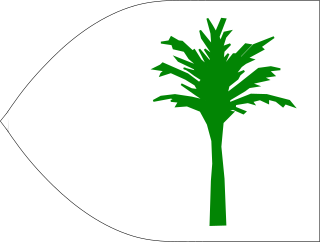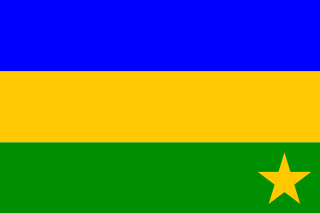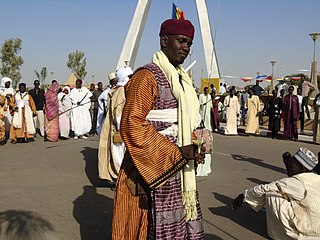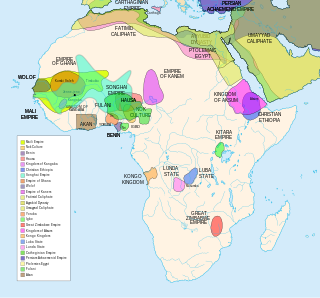Related Research Articles
Chad, officially the Republic of Chad, is a landlocked country in Central Africa. It borders Libya to the north, Sudan to the east, the Central African Republic to the south, Cameroon and Nigeria to the southwest, and Niger to the west. Due to its distance from the sea and its largely desert climate, the country is sometimes referred to as the "Dead Heart of Africa".

The Kanem–Bornu Empire existed in areas which are now part of Nigeria, Niger, Cameroon, Libya and Chad. It was known to the Arabian geographers as the Kanem Empire from the 8th century AD onward and lasted as the independent kingdom of Bornu until 1900.

Central Africa is a subregion of the African continent comprising various countries according to different definitions. Middle Africa is an analogous term used by the United Nations in its geoscheme for Africa and consists of the following countries: Angola, Burundi, Cameroon, Central African Republic, Chad, Democratic Republic of the Congo, Republic of the Congo, Equatorial Guinea, Gabon, Rwanda, and São Tomé and Príncipe. These eleven countries are members of the Economic Community of Central African States (ECCAS). Six of those countries are also members of the Economic and Monetary Community of Central Africa (CEMAC) and share a common currency, the Central African CFA franc.

The Kanuri people are an African ethnic group living largely in the lands of the former Kanem and Bornu Empires in Niger, Nigeria, Chad, and Cameroon. As well as a diaspora community residing in Sudan. Those generally termed Kanuri include several subgroups and dialect groups, some of whom identify as distinct from the Kanuri. Most trace their origins to ruling lineages of the medieval Kanem-Bornu Empire, and its client states or provinces. In contrast to the neighboring Toubou or Zaghawa pastoralists, Kanuri groups have traditionally been sedentary, engaging in farming, fishing the Chad Basin, trade, and salt processing.

The Sahelian kingdoms were a series of centralized kingdoms or empires that were centered on the Sahel, the area of grasslands south of the Sahara, from the 8th century to the 19th. The wealth of the states came from controlling the trade routes across the desert. Their power came from having large pack animals like camels and horses that were fast enough to keep a large empire under central control and were also useful in such kind of battle. All of these empires were also quite decentralized with member cities having a great deal of autonomy.
Ngazargamu, Birni Ngazargamu, Birnin Gazargamu, Gazargamo or N'gazargamu, was the capital of the Bornu Empire from ca. 1460 to 1809. Situated 150 km (93 mi) west of Lake Chad in the Yobe State of modern Nigeria, the remains of the former capital city are still visible. The surrounding wall is 6.6 km (4.1 mi) long and in parts it is still up to 5 m (16 ft) high.
The Zaghawa people, also called Beri or Zakhawa, are an ethnic group primarily residing in southwestern Libya, northeastern Chad, and western Sudan, including Darfur.

The Kanembu are an ethnic group of Chad, generally considered the modern descendants of the Kanem-Bornu Empire. The Kanembu are estimated to number 1,815,270 people, located primarily in Chad's Lac Prefecture but also in Chari-Baguirmi and Kanem prefectures. They speak the Kanembu language, which the Kanuri language is closely related to, with many speaking Arabic and sometimes nowadays French as a second language.

Sayfawa dynasty, Sefouwa, Sefawa, or Sefuwa dynasty is the name of the Muslim kings of the Kanem–Bornu Empire, centered first in Kanem in western Chad, and then, after 1380, in Borno.
Dunama Dabbalemi, or Dounama Dibbalém, of the Sayfawa dynasty, was the mai (king) of the Kanem Empire, in present-day Chad, from 1210 to 1224.
al-Haj Idris Alooma was Mai (ruler) of the Bornu empire, covering parts of Chad, Cameroon, Niger and Nigeria. His achievements are primarily chronicled by Ahmad bin Fartuwa, his chief Imam. His reign marked the end of the Kanem civil wars within the state, reuniting N'jimi, the former capital, under Sayfawa control. Furthermore, he introduced significant legal reforms based on Islamic law, establishing qadi courts that operated independently from the executive branch. He is credited with leading the empire to what is often regarded as its zenith during the late 16th-century and early 17th-century.

Hausa Kingdoms, also known as Hausa Kingdom or Hausaland, was a collection of states started by the Hausa people, situated between the Niger River and Lake Chad. Hausaland lay between the Western Sudanic kingdoms of Ancient Ghana, Mali and Songhai and the Eastern Sudanic kingdoms of Kanem-Bornu. Hausaland took shape as a political and cultural region during the first millennium CE as a result of the westward expansion of Hausa peoples. They arrived to Hausaland when the terrain was converting from woodlands to savannah. They started cultivating grains, which led to a denser peasant population. They had a common language, laws and customs. The Hausa were known for fishing, hunting, agriculture, salt-mining, and blacksmithing.
The Girgam is the royal chronicle of the Kanem–Bornu Empire, written in Arabic. Girgam is also used as the name for written historical records in some kingdoms west of Bornu, including Daura, Fika and Mandara, defined as "chronicle or 'list of ancestors'" or simply "date".
Ahmad bin Furtu or Ibn Furtu was the sixteenth century grand Imam of the Bornu Empire and the chronicler of Mai Idris Alooma (1564–1596).

The history of Nigeria before 1500 has been divided into its prehistory, Iron Age, and flourishing of its kingdoms and states. Acheulean tool-using archaic humans may have dwelled throughout West Africa since at least between 780,000 BP and 126,000 BP. Middle Stone Age West Africans likely dwelled continuously in West Africa between MIS 4 and MIS 2, and Iwo Eleru people persisted at Iwo Eleru as late as 13,000 BP. West African hunter-gatherers occupied western Central Africa earlier than 32,000 BP, dwelled throughout coastal West Africa by 12,000 BP, and migrated northward between 12,000 BP and 8000 BP as far as Mali, Burkina Faso, and Mauritania. The Dufuna canoe, a dugout canoe found in northern Nigeria has been dated to around 6556-6388 BCE and 6164-6005 BCE, making it the oldest known boat in Africa and the second oldest worldwide.
Omar Ibn Idris, or Umar Idrismi, Idris Dunama III, was the ruler of the Kanem Empire from 1372 to 1380. He moved the capital from Njimi, Kanem to Kaga, located on the western edge of Lake Chad in present day Borno State, Nigeria.

This is a timeline of Nigerian history, comprising important legal and territorial changes and political events in Nigeria and its predecessor states. To read about the background to these events, see History of Nigeria. See also the list of heads of state of Nigeria.

African empires is an umbrella term used in African studies to refer to a number of pre-colonial African kingdoms in Africa with multinational structures incorporating various populations and polities into a single entity, usually through conquest.
Zawila is a village in southwestern Libya. During the Middle Ages, it was the capital of the Fezzan region.

The history of Central Africa has been divided into its prehistory, its ancient history, the major polities flourishing, the colonial period, and the post-colonial period, in which the current nations were formed. Central Africa is the central region of Africa, bordered by North Africa, West Africa, East Africa, Southern Africa, the Atlantic Ocean, and the Sahara Desert. Colonial boundaries are reflected in the modern boundaries between contemporary Central African states, cutting across ethnic and cultural lines, often dividing single ethnic groups between two or more states.
References
- 1 2 Connah, Graham (1987). African Civilizations: Precolonial cities and states in tropical Africa: an archaeological perspective . Cambridge: Cambridge University Press. ISBN 0-521-26666-1.